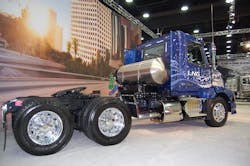Will natural gas stall out as heavy-duty alternative?
Just two years ago, natural gas was forecast to fuel up to 20% of new heavy-duty trucks by the end of the decade. But now, thanks to everything from declining diesel prices to fleet concerns about natural-gas payback and fueling infrastructure, it appears those earlier predictions of the future strength of natural gas were too rosy.
For example, ACT Research describes its previous study on natural-gas fuel trends (updated in January, 2013) as “more bullish” than the one it released just yesterday.
The earlier report had reflected “the enthusiasm of the moment that included planned market and product development that has been slow to materialize with a narrowing fuel price spread and improving diesel engine fuel economy gains,” explained the research and analysis firm.
That study had discussed what ACT termed at the time was “a major concern-- the viability of these [natural gas] savings long-term,” including whether the price of natural gas will “remain positive and highly competitive against other fuels.”
As for its new report, titled “NG Reality Check: Moving from Infancy to Adolescence,” ACT noted outright that its release coincides with “the natural gas-powered vehicle market seemingly stalled as diesel fuel prices continue to drop.”
However, said Ken Vieth, ACT Research’s senior partner & general manager, the “previous long-term penetration over-statement does not mean NG has not grown. It has and will continue to grow, but at a slower rate the next few years.”
Vieth advised more specifically that related that the “NG Class 8 truck/transit bus penetration was 3% in 2013 and should reach 4% in 2014, or about 11,000 units.”
Looking further out, Vieth said that with “the most likely adoption curve, NG heavy class 8 penetration is expected to total 23% of the units sold in 2025. If the total new U.S. class 8 truck/transit bus market is 200,000 units that year, then the NG market will be a strong 46,000 units.
“That’s a large quantity that will be shared by those with an understanding of tomorrow’s truck transportation needs and plans to get there,” he continued.
Vieth also remarked that “depending upon the emissions and greenhouse gas needs of the nation and the regulations put in place in coming years to achieve those needs, NG penetration could even be higher since NG is equally available and is a cleaner, cheaper (CPM) fuel than diesel.”
Factoring in his take on how big a role LNG may wind up playing in the fleet market, Jon Gabrielsen, president & CEO of J.T. Gabrielsen Consulting LLC, told FleetOwner that he is more bearish about the future of natural-gas power in heavy-duty trucks.
“I cannot disagree with ACT’s estimates for 2014, as any vehicles entering service this year were ordered based upon a diesel vs LNG price relationship that was still favorable to LNG,” said Gabrielsen.
As for the long-term outlook, Gabrielsen said that “even if you assume that the economics of LNG would be very positive,” said Gabrielsen, “if you think though the mix of end- user purchasers of heavy duty on-highway truck, their applications for those trucks, and their purchase decision behaviors, it is difficult to come up to even half of the penetration rate they are estimating for 2025.”
He also advised that “the most likely future scenario” will involve “oil prices taking some time to find their new level. But eventually, they will be in a range of $75 to $85/bbl. That would put the average U.S. diesel price at about $3.25 to $3.50/gallon.
“At that diesel price,” Gabrielsen continued, “what little savings there may be at the pump would not be sufficient to generate the payback that the vast majority of fleets would require for the higher investment needed for LNG-fueled trucks vs. conventional diesel-fueled trucks.”
“NG Reality Check,” described by ACT as “a comprehensive, forward-looking long-term analysis on the use of natural gas as fuel in U.S. heavy Class 8 truck transportation,” includes forecasts, insights and supporting analysis on these major trends already under way:
• NG engine technologies (spark, HPDI, dual fuel)
• NG fuel preference (LNG, CNG, DME)
• Infrastructure design (fuel only to full service and fuels)
• Emerging infrastructure investors and early NG adopters
• ROI adjustments as fuel cost spreads and up-charges change
• MPG versus CPM (cost per mile)
• Shipper-trucker relationships from contracts to diesel fuel surcharges to going green etc.
